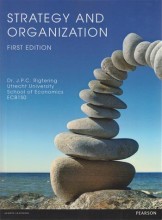Summary: Strategy And Organization
- This + 400k other summaries
- A unique study and practice tool
- Never study anything twice again
- Get the grades you hope for
- 100% sure, 100% understanding
Read the summary and the most important questions on Strategy and Organization
-
1 Competitive Strategy
This is a preview. There are 1 more flashcards available for chapter 1
Show more cards here -
What is the view of Buzzell & Gale (1987) on competitive strategy and which factors do they take in account?
Instead of portfolio planning they use PIMS (Profit Impact Market Strategy). They identify factors in the market in order to create financial objectives for a business and some of the characteristics of a strategy. These factors depend on the business characteristics of the marketplace (outside-in). The main factor named by Buzzell & Gale regarding profitability is the quality of the product. -
What is the view of Porter (1979) on competitive strategy?
external forces determine the attractiveness of the industry using the five forces model (substitutes, new entrants, suppliers, buyers, rivalry among existing firms). These factors lead to 3 suitable strategies; cost leadership, focus of differentiation. -
What do Baden-Fuller and Stopford (1992) claim regarding competitive strategy?
that growth rate of the industry is a reflection of the kind of business in the industry, not the nature of the environment (inside-out). This means that the real battles are from companies with different approaches to the market. -
What is the main idea of Barney (1991)?
Resources lead to competitive advantages. This comes from learning from best practices and should and resources can be possessed (bezitten) or acquired. The firms resource should be homogene (different than those of other companies) and immobile. If resources are VRIN (valuable, rare, imperfect imitable and non-substitutional) that these lead to sustained competitive advantage. -
What is the main idea of Grant and Baden-Fuller (2004) regarding competitive strategy?
Strategic alliances can create valuable resources by accessing knowledge (Knowledge based view, inside-out). Two forms of strategic alliances are knowledge generation (acquiring) and knowledge application (use knowledge to create value) -
What is a deterministic view?
The environment determines the optimal strategy for a firm -
What is a voluntaristic view?
Firms can actively influence the environment through their strategy -
What is the essence of the positioning school?
Positioning school has a deterministic view on strategy and see strategy in terms of 'fit'. This fit means a perfect fit in the environment by taking a favorable competitive position in the market. There are barriers in the market that limit profitability. The positions are derived from a limited amount of strategies (cost, focus or differentiation). Also, essence of strategy is analysis. -
What is the essence of the resource-based school?
The resource based school has a voluntaristic view on strategy and thinks in terms of stretch. managers should become entrepreneurs who change the environment. Because the resources and environment are constantly changing, one cannot see strategy as a static 'fit'. -
What are differences within the resource-based school?
- resource (Barney) vs knowledge (Baden-Fuller)
- possession or acquiring (Barney) vs access (Baden-Fuller)
- environment is constant (Barney) vs environment is uncertain (Baden-Fuller)
- Higher grades + faster learning
- Never study anything twice
- 100% sure, 100% understanding






























